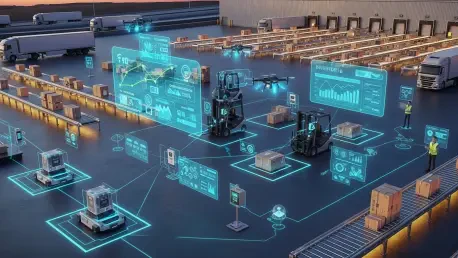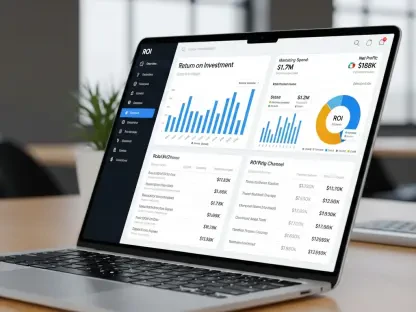The Retail Supply Chain Landscape: A Broader View
The retail supply chain in the United States stands as a cornerstone of the national economy, facilitating the movement of goods worth trillions of dollars annually and supporting millions of jobs across diverse sectors. This intricate network ensures that products reach consumers swiftly, from sprawling urban centers to remote rural areas, underpinning the retail industry’s ability to meet ever-growing demand. Its significance is evident in its contribution to GDP and its role in maintaining the flow of essential goods, especially during times of crisis or disruption.
Key segments within this landscape include logistics, which handles transportation and warehousing; inventory management, critical for balancing stock levels; and cold chain operations, vital for preserving perishable items like food and pharmaceuticals. Each segment faces unique pressures, such as rising fuel costs, labor shortages, and the need for precision in handling temperature-sensitive products. Major players like Walmart dominate this space, alongside competitors who are increasingly turning to technology to gain an edge in efficiency and responsiveness.
Technological advancements, particularly the Internet of Things (IoT) and artificial intelligence (AI), are reshaping how supply chains operate, offering real-time insights and automation capabilities. Meanwhile, regulatory frameworks, especially around food safety and data privacy, impose strict guidelines that companies must navigate to avoid penalties and maintain consumer trust. These regulations, while necessary, often add layers of complexity to adopting innovative solutions, creating a dynamic environment where adaptation is both a challenge and an opportunity.
Walmart and Wiliot Partnership: Transforming Retail Logistics
Key Trends Driving Innovation in Supply Chain Management
The retail sector is witnessing a seismic shift toward data-driven operations, with IoT and AI becoming integral to capturing real-time information and enhancing decision-making processes. These technologies enable companies to monitor goods throughout their journey, reducing errors and optimizing routes. This trend aligns with broader consumer expectations for quicker, more reliable deliveries, pushing retailers to rethink traditional logistics models.
Automation is another transformative force, streamlining repetitive tasks and cutting operational costs while addressing labor constraints. Market drivers, such as stringent cold chain compliance for perishables and the demand for precise inventory tracking, further fuel the adoption of advanced systems. Ambient IoT technology, which embeds sensors into everyday objects for seamless data collection, emerges as a promising solution, offering scalability and efficiency gains that traditional methods struggle to match.
This convergence of innovation opens up significant opportunities for retailers to overhaul their supply chains. By leveraging ambient IoT, companies can achieve unprecedented visibility into their operations, paving the way for smarter resource allocation and waste reduction. Such advancements are not merely incremental but represent a fundamental reimagining of how goods move from supplier to shelf.
Scope and Scale of the Deployment
Walmart has partnered with technology innovator Wiliot to roll out ambient IoT sensors across its expansive US network, starting with 500 locations and targeting an ambitious expansion to 4,600 stores by next year. This deployment encompasses all Walmart Supercenters, Neighborhood Markets, and over 40 distribution centers, marking one of the largest implementations of its kind in retail history. The initiative aims to integrate 90 million IoT Pixels by the end of this year, fully digitizing the supply chain.
These IoT Pixels, small yet powerful sensors, transmit real-time data to Walmart’s AI systems, providing granular insights into the location and condition of goods, particularly pallets of groceries. This capability is expected to drastically improve operational efficiency by automating alerts and minimizing manual intervention. The impact on market positioning is profound, with projections suggesting a significant boost in Walmart’s ability to manage inventory and meet customer demands more effectively.
Beyond immediate benefits, this rollout positions Walmart as a leader in retail logistics innovation, setting a benchmark for scale and integration. The partnership not only enhances internal processes but also strengthens Walmart’s competitive stance in a market where speed and accuracy are paramount. As deployment progresses, the ripple effects on industry standards and practices are likely to be substantial.
Challenges in Adopting Ambient IoT Technology
Implementing ambient IoT on such a massive scale presents notable technological hurdles, particularly in integrating these new systems with Walmart’s existing infrastructure. Compatibility issues between legacy software and cutting-edge sensors could lead to delays or inefficiencies if not addressed proactively. Ensuring seamless data flow across thousands of locations requires robust technical planning and execution.
Market-driven challenges also loom large, with the high upfront costs of deploying millions of sensors posing a financial risk, especially if returns on investment take longer than anticipated. Scalability concerns arise as well, given the diverse nature of Walmart’s operations across urban and rural settings. Overcoming these barriers demands strategic phasing of the rollout to manage costs and mitigate potential disruptions.
Workforce adaptation adds another layer of complexity, as employees must be trained to interact with and trust new tools that alter traditional workflows. Resistance to change or skill gaps could slow adoption rates, necessitating comprehensive training programs. Solutions like gradual implementation and AI-driven support systems can ease this transition, ensuring that technology empowers rather than overwhelms the workforce.
Regulatory and Compliance Considerations
Deploying IoT technology in supply chains must align with stringent regulatory standards, particularly concerning data security and privacy. With vast amounts of real-time information being transmitted, adherence to federal and state guidelines on protecting sensitive data is non-negotiable. Non-compliance risks not only legal repercussions but also erosion of customer confidence in how personal or operational data is handled.
Food safety laws further complicate the landscape, especially for cold chain operations involving perishables like dairy and meat. Maintaining precise temperature controls and documenting compliance through IoT data is critical to meeting health and safety requirements. Any lapse in this area could result in costly recalls or damage to brand reputation, underscoring the need for reliable systems.
Regulatory changes can also impact the pace of technology adoption, as evolving policies may require adjustments to sensor deployment or data management practices. Retailers must prioritize privacy and security in their IoT frameworks, embedding safeguards into every layer of the supply chain. Staying ahead of these compliance demands ensures not just legal adherence but also operational resilience in a tightly regulated industry.
Future Outlook: The Next Frontier for Retail Supply Chains
Ambient IoT and AI are poised to redefine retail logistics by enabling unprecedented levels of transparency and control over supply chain processes. These technologies will likely drive a shift toward predictive analytics, where potential disruptions are identified and addressed before they occur. This proactive approach could become the new standard for efficiency in the coming years.
Market disruptors, including emerging technologies like blockchain for traceability and competitive responses from other retailers, are expected to intensify innovation in this space. Consumer preferences are also evolving, with greater emphasis on sustainability and visibility into product origins, pushing companies to integrate ethical practices into their operations. Ambient IoT offers a pathway to meet these demands by providing detailed tracking capabilities.
Global economic conditions, such as fluctuating trade policies or supply shortages, will continue to influence the trajectory of retail supply chains, alongside the pace of technological advancement. Retailers that invest in adaptable, scalable solutions now stand to gain a long-term advantage. The interplay of these factors suggests a future where agility and data-driven strategies are critical to maintaining relevance in a fast-changing market.
Conclusion
Reflecting on this transformative partnership, Walmart’s integration of ambient IoT with Wiliot marks a turning point in retail logistics, showcasing how technology can address longstanding inefficiencies. The initiative demonstrates tangible gains in inventory accuracy and cold chain compliance, setting a powerful example for the industry. It also highlights the potential for automation to reduce manual workloads, freeing up resources for strategic priorities.
Looking ahead, other retailers should consider piloting similar technologies, starting with smaller-scale deployments to test feasibility and build internal expertise. Collaboration with technology providers can accelerate this process, ensuring access to cutting-edge solutions tailored to specific needs. Investing in workforce training emerges as a critical step to maximize the benefits of such innovations.
Ultimately, the path forward lies in embracing a mindset of continuous improvement, where data and innovation drive decision-making. Retailers that prioritize adaptability and transparency in their supply chains stand to not only enhance operational performance but also build stronger connections with consumers. This pioneering effort by Walmart offers a glimpse into a future where technology and strategy converge to redefine industry standards.









